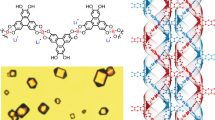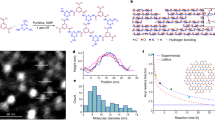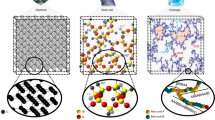Abstract
Molecular daisy chains are mechanically bonded materials with unique properties and compelling structures. Despite the exploration of numerous daisy chain structures, the synthesis of a crystalline mechanically interlocked polymer comprising daisy chain units remains elusive because flexible linkers typically yield amorphous gels, while rigid structures lack processability. Here we combine supramolecular crystallization preorganization with post-insertion of mechanical bonds to address this limitation. We use a C3-symmetric tritopic monomer with ammonium moieties and oligoether arms to generate a preorganized supramolecular honeycomb-like crystalline network via complementary non-covalent interactions, in an aqueous environment. Subsequently, single-crystal-to-single-crystal transformation-directed thiol–ene click chemistry crosslinks terminal alkenes at the end of the oligoether arms using 1,2-ethanedithiol, covalently locking [c2]daisy chain linkages while preserving long-range order. This two-dimensional mechanically interlocked polymer can be exfoliated from its crystals to generate a multilayer counterpart exhibiting a 47-fold stiffness enhancement relative to its bulk parent. Moreover, the trilayer nanosheets preserve the structural integrity with the same hexagonal symmetry as the bulk parent. Our method enables the synthesis of a single-crystalline two-dimensional mechanically interlocked polymer from flexible monomers with precise synthetic control and unlocks the potential of developing mechanically interlocked materials.

This is a preview of subscription content, access via your institution
Access options
Subscribe to this journal
Receive 12 digital issues and online access to articles
$119.00 per year
only $9.92 per issue
Buy this article
- Purchase on SpringerLink
- Instant access to full article PDF
Prices may be subject to local taxes which are calculated during checkout






Similar content being viewed by others
Data availability
All data that support the findings of this study are available in the Article and Supplementary Information. Crystallographic data for the structures reported in this Article have been deposited at the Cambridge Crystallographic Data Centre, under deposition numbers CCDC 2300835 for D1 and CCDC 2300836 for D2. Copies of the data can be obtained free of charge via https://www.ccdc.cam.ac.uk/structures/. Source data are provided with this paper.
References
Gee, G. & Rideal, E. K. Reaction in monolayers of drying oils I-The oxidation of the maleic anhydride compound of β-elaeostearin. Proc. R. Soc. Lond. A 153, 116–128 (1935).
Sakamoto, J., van Heijst, J., Lukin, O. & Schlüter, A. D. Two-dimensional polymers: just a dream of synthetic chemists? Angew. Chem. Int. Ed. 48, 1030–1069 (2009).
Bauer, T. et al. Synthesis of free-standing, monolayered organometallic sheets at the air/water interface. Angew. Chem. Int. Ed. 50, 7879–7884 (2011).
Colson, J. W. & Dichtel, W. R. Rationally synthesized two-dimensional polymers. Nat. Chem. 5, 453–465 (2013).
Nugent, P. et al. Porous materials with optimal adsorption thermodynamics and kinetics for CO2 separation. Nature 495, 80–84 (2013).
Akinwande, D., Petrone, N. & Hone, J. Two-dimensional flexible nanoelectronics. Nat. Commun. 5, 5678 (2014).
Bae, S.-H. et al. Integration of bulk materials with two-dimensional materials for physical coupling and applications. Nat. Mater. 18, 550–560 (2019).
Takata, T., Kihara, N. & Furusho, Y. Polyrotaxanes and polycatenanes: recent advances in syntheses and applications of polymers comprising of interlocked structures. Adv. Polym. Sci. 171, 1–75 (2004).
Mena-Hernando, S. & Pérez, E. M. Mechanically interlocked materials. Rotaxanes and catenanes beyond the small molecule. Chem. Soc. Rev. 48, 5016–5032 (2019).
Hart, L. F. et al. Material properties and applications of mechanically interlocked polymers. Nat. Rev. Mater. 6, 508–530 (2021).
Okumura, Y. & Ito, K. The polyrotaxane gel: a topological gel by figure-of-eight cross-links. Adv. Mater. 13, 485–487 (2001).
Bissell, R. A., Córdova, E., Kaifer, A. E. & Stoddart, J. F. A chemically and electrochemically switchable molecular shuttle. Nature 369, 133–137 (1994).
Kay, E. R., Leigh, D. A. & Zerbetto, F. Synthetic molecular motors and mechanical machines. Angew. Chem. Int. Ed. 46, 72–191 (2007).
Feringa, B. L. The art of building small: from molecular switches to motors (Nobel Lecture). Angew. Chem. Int. Ed. 56, 11060–11078 (2017).
Stoddart, J. F. Mechanically interlocked molecules (MIMs)—molecular shuttles, switches, and machines (Nobel Lecture). Angew. Chem. Int. Ed. 56, 11094–11125 (2017).
Harada, A., Li, J. & Kamachi, M. The molecular necklace: a rotaxane containing many threaded α-cyclodextrins. Nature 356, 325–327 (1992).
Huang, F. & Gibson, H. W. Polypseudorotaxanes and polyrotaxanes. Prog. Polym. Sci. 30, 982–1018 (2005).
Harada, A., Hashidzume, A., Yamaguchi, H. & Takashima, Y. Polymeric rotaxanes. Chem. Rev. 109, 5974–6023 (2009).
Arunachalam, M. & Gibson, H. W. Recent developments in polypseudorotaxanes and polyrotaxanes. Prog. Polym. Sci. 39, 1043–1073 (2014).
Guidry, E. N., Li, J., Stoddart, J. F. & Grubbs, R. H. Bifunctional [c2]daisy-chains and their incorporation into mechanically interlocked polymers. J. Am. Chem. Soc. 129, 8944–8945 (2007).
Clark, P. G., Day, M. W. & Grubbs, R. H. Switching and extension of a [c2]daisy-chain dimer polymer. J. Am. Chem. Soc. 131, 13631–13633 (2009).
Rotzler, J. & Mayor, M. Molecular daisy chains. Chem. Soc. Rev. 42, 44–62 (2013).
Van Raden, J. M., Jarenwattananon, N. N., Zakharov, L. N. & Jasti, R. Active metal template synthesis and characterization of a nanohoop [c2]daisy chain rotaxane. Chem. Eur. J. 26, 10205–10209 (2020).
Niu, Z. & Gibson, H. W. Polycatenanes. Chem. Rev. 109, 6024–6046 (2009).
Gil-Ramírez, G., Leigh, D. A. & Stephens, A. J. Catenanes: fifty years of molecular links. Angew. Chem. Int. Ed. 54, 6110–6150 (2015).
Liu, J. et al. Infinite twisted polycatenanes. Angew. Chem. Int. Ed. 62, e202314481 (2023).
Noda, Y., Hayashi, Y. & Ito, K. From topological gels to slide-ring materials. J. Appl. Polym. Sci. 131, 40509 (2014).
Liu, C. et al. Tough hydrogels with rapid self-reinforcement. Science 372, 1078–1081 (2021).
Anelli, P. L., Spencer, N. & Stoddart, J. F. A molecular shuttle. J. Am. Chem. Soc. 113, 5131–5133 (1991).
Hubin, T. J. & Busch, D. H. Template routes to interlocked molecular structures and orderly molecular entanglements. Coord. Chem. Rev. 200–202, 5–52 (2000).
Beves, J. E., Blight, B. A., Campbell, C. J., Leigh, D. A. & McBurney, R. T. Strategies and tactics for the metal-directed synthesis of rotaxanes, knots, catenanes, and higher order links. Angew. Chem. Int. Ed. 50, 9260–9327 (2011).
Sluysmans, D. & Stoddart, J. F. The burgeoning of mechanically interlocked molecules in chemistry. Trends Chem. 1, 185–197 (2019).
Weidmann, J.-L. et al. Poly[2]catenanes and cyclic oligo[2]catenanes containing alternating topological and covalent bonds: synthesis and characterization. Chem. Eur. J. 5, 1841–1851 (1999).
Wu, Q. et al. Poly[n]catenanes: synthesis of molecular interlocked chains. Science 358, 1434–1439 (2017).
Du, R. et al. A highly stretchable and self-healing supramolecular elastomer based on sliding crosslinks and hydrogen bonds. Adv. Funct. Mater. 30, 1907139 (2020).
Ikejiri, S., Takashima, Y., Osaki, M., Yamaguchi, H. & Harada, A. Solvent-free photoresponsive artificial muscles rapidly driven by molecular machines. J. Am. Chem. Soc. 140, 17308–17315 (2018).
Nakahata, M., Mori, S., Takashima, Y., Yamaguchi, H. & Harada, A. Self-healing materials formed by cross-linked polyrotaxanes with reversible bonds. Chem 1, 766–775 (2016).
Choi, S., Kwon, T.-w, Coskun, A. & Choi, J. W. Highly elastic binders integrating polyrotaxanes for silicon microparticle anodes in lithium ion batteries. Science 357, 279–283 (2017).
Li, J. et al. Cationic supramolecules composed of multiple oligoethylenimine-grafted β-cyclodextrins threaded on a polymer chain for efficient gene delivery. Adv. Mater. 18, 2969–2974 (2006).
Cotí, K. K. et al. Mechanised nanoparticles for drug delivery. Nanoscale 1, 16–39 (2009).
Choi, J. W. et al. Ground-state equilibrium thermodynamics and switching kinetics of bistable [2]rotaxanes switched in solution, polymer gels, and molecular electronic devices. Chem. Eur. J. 12, 261–279 (2006).
Deng, H., Olson, M. A., Stoddart, J. F. & Yaghi, O. M. Robust dynamics. Nat. Chem. 2, 439–443 (2010).
Liu, Y. et al. Weaving of organic threads into a crystalline covalent organic framework. Science 351, 365–369 (2016).
Ma, T. et al. Catenated covalent organic frameworks constructed from polyhedra. Nat. Synth. 2, 286–295 (2023).
Prakasam, T. et al. 2D covalent organic framework via catenation. Chem 11, 102307 (2025).
Fang, L. et al. Mechanically bonded macromolecules. Chem. Soc. Rev. 39, 17–29 (2010).
Ashton, P. R. et al. Supramolecular daisy chains. Angew. Chem. Int. Ed. 37, 1294–1297 (1998).
Fang, L. et al. Acid–base actuation of [c2]daisy chains. J. Am. Chem. Soc. 131, 7126–7134 (2009).
Bruns, C. J. et al. Redox switchable daisy chain rotaxanes driven by radical–radical interactions. J. Am. Chem. Soc. 136, 4714–4723 (2014).
Jiménez, M. C., Dietrich-Buchecker, C. & Sauvage, J.-P. Towards synthetic molecular muscles: contraction and stretching of a linear rotaxane dimer. Angew. Chem. Int. Ed. 39, 3284–3287 (2000).
Cai, K. et al. Radical cyclic [3]daisy chains. Chem 7, 174–189 (2021).
Iwaso, K., Takashima, Y. & Harada, A. Fast response dry-type artificial molecular muscles with [c2]daisy chains. Nat. Chem. 8, 625–632 (2016).
Goujon, A. et al. Bistable [c2] daisy chain rotaxanes as reversible muscle-like actuators in mechanically active gels. J. Am. Chem. Soc. 139, 14825–14828 (2017).
Zhang, M. et al. Preparation of a daisy chain via threading-followed-by-polymerization. Macromolecules 44, 9629–9634 (2011).
Wang, Y. et al. Mechanically interlocked [an]daisy chain networks. Chem 9, 2206–2221 (2023).
Zhang, Q. et al. Muscle-like artificial molecular actuators for nanoparticles. Chem 4, 2670–2684 (2018).
Du, G., Moulin, E., Jouault, N., Buhler, E. & Giuseppone, N. Muscle-like supramolecular polymers: integrated motion from thousands of molecular machines. Angew. Chem. Int. Ed. 51, 12504–12508 (2012).
Amirsakis, D. G. et al. Diastereospecific photochemical dimerization of a stilbene-containing daisy chain monomer in solution as well as in the solid state. Angew. Chem. Int. Ed. 42, 1126–1132 (2003).
Bruns, C. J. & Stoddart, J. F. Molecular machines muscle up. Nat. Nanotechnol. 8, 9–10 (2013).
Gao, L., Zhang, Z., Zheng, B. & Huang, F. Construction of muscle-like metallo-supramolecular polymers from a pillar[5]arene-based [c2]daisy chain. Polym. Chem. 5, 5734–5739 (2014).
Goujon, A. et al. Controlled sol–gel transitions by actuating molecular machine based supramolecular polymers. J. Am. Chem. Soc. 139, 4923–4928 (2017).
Chang, J.-C. et al. Mechanically interlocked daisy-chain-like structures as multidimensional molecular muscles. Nat. Chem. 9, 128–134 (2017).
Samanta, J. et al. An ultra-dynamic anion-cluster-based organic framework. Chem 8, 253–267 (2022).
Kade, M. J., Burke, D. J. & Hawker, C. J. The power of thiol-ene chemistry. J. Polym. Sci. A Polym. Chem. 48, 743–750 (2010).
Kory, M. J. et al. Gram-scale synthesis of two-dimensional polymer crystals and their structure analysis by X-ray diffraction. Nat. Chem. 6, 779–784 (2014).
Kissel, P., Murray, D. J., Wulftange, W. J., Catalano, V. J. & King, B. T. A nanoporous two-dimensional polymer by single-crystal-to-single-crystal photopolymerization. Nat. Chem. 6, 774–778 (2014).
Guo, Q.-H. et al. Single-crystal polycationic polymers obtained by single-crystal-to-single-crystal photopolymerization. J. Am. Chem. Soc. 142, 6180–6187 (2020).
Kissel, P. et al. A two-dimensional polymer prepared by organic synthesis. Nat. Chem. 4, 287–291 (2012).
Bunck, D. N. & Dichtel, W. R. Bulk synthesis of exfoliated two-dimensional polymers using hydrazone-linked covalent organic frameworks. J. Am. Chem. Soc. 135, 14952–14955 (2013).
Gallego, A. et al. Solvent-induced delamination of a multifunctional two dimensional coordination polymer. Adv. Mater. 25, 2141–2146 (2013).
Dong, J. et al. Free-standing homochiral 2D monolayers by exfoliation of molecular crystals. Nature 602, 606–611 (2022).
Zhang, K.-D. et al. Toward a single-layer two-dimensional honeycomb supramolecular organic framework in water. J. Am. Chem. Soc. 135, 17913–17918 (2013).
Li, Y.-L. et al. Record complexity in the polycatenation of three porous hydrogen-bonded organic frameworks with stepwise adsorption behaviors. J. Am. Chem. Soc. 142, 7218–7224 (2020).
Acknowledgements
We are grateful for financial support from the National Natural Science Foundation of China (22171232 and 21971211), the ‘Spearhead’ and ‘Leading Goose’ Research and Development Program of Zhejiang Province (2024SDXHDX0008), the Natural Science Foundation of Anhui Province (2108085MB31), the University Synergy Innovation Program of Anhui Province (GXXT-2021-064), the Excellent Research and Innovation Team Project of Anhui Province (2022AH010001) and Zhejiang Provincial Key Laboratory Construction Project. We extend our gratitude to Z. Chen and Z. Yang from the Instrumentation and Service Centers for Molecular Science and Physical Sciences, respectively at Westlake University for assistance with Raman and nanoindentation measurement as well as the data interpretation. The research was supported by Westlake University HPC Center. We also thank the staff at the SSRF BL17B1 beamline of the National Facility for Protein Science in Shanghai (NFPS), Shanghai Advanced Research Institute, CAS, for providing technical support with X-ray diffraction data collection and analysis.
Author information
Authors and Affiliations
Contributions
Z.L. conceived the idea. L.B., Z.-B.T. and Z.L. conducted experiments, analysed the results and prepared the Supplementary Information. X.M. and Z.-B.T. provided insightful discussions on X-ray diffraction measurement. Z.-B.T. and Z.L. wrote the manuscript. H.G. and L.X. carried out the HRESI-MS measurements. Z.-B.T. and H.G. performed the nanoindentation and Raman measurements. L.L. and X.Z. provided assistance with AFM measurements. Q.J. offered support with HRTEM measurement. D.S. and A.C.-H.S. discussed and revised the manuscript.
Corresponding author
Ethics declarations
Competing interests
The authors declare no competing interests.
Peer review
Peer review information
Nature Synthesis thanks the anonymous reviewers for their contribution to the peer review of this work. Primary Handling Editor: Alison Stoddart, in collaboration with the Nature Synthesis team.
Additional information
Publisher’s note Springer Nature remains neutral with regard to jurisdictional claims in published maps and institutional affiliations.
Supplementary information
Supplementary Information
Supplementary Scheme 1, Figs. 1–34, Tables 1 and 2, Refs. 1–8, Experimental details and X-ray crystallographic details.
Supplementary Data 1
Crystal data for D1, CCDC 2300835.
Supplementary Data 2
Crystal data for D2, CCDC 2300836.
Source data
Source Data Fig. 5
Height profiles and Young’s modulus of exfoliated D2 films.
Source Data Fig. 6
Height profiles of the exfoliated nanosheets of D2.
Rights and permissions
Springer Nature or its licensor (e.g. a society or other partner) holds exclusive rights to this article under a publishing agreement with the author(s) or other rightsholder(s); author self-archiving of the accepted manuscript version of this article is solely governed by the terms of such publishing agreement and applicable law.
About this article
Cite this article
Tang, ZB., Bian, L., Miao, X. et al. Synthesis of a crystalline two-dimensional [c2]daisy chain honeycomb network. Nat. Synth 4, 922–930 (2025). https://doi.org/10.1038/s44160-025-00791-x
Received:
Accepted:
Published:
Issue date:
DOI: https://doi.org/10.1038/s44160-025-00791-x
This article is cited by
-
Supramolecular templating for two-dimensional crystalline polymers with mechanical bonds
Nature Synthesis (2025)
-
A two-dimensional mechanically interlocked polymer crosslinked by [c2]daisy chains
Science China Chemistry (2025)



